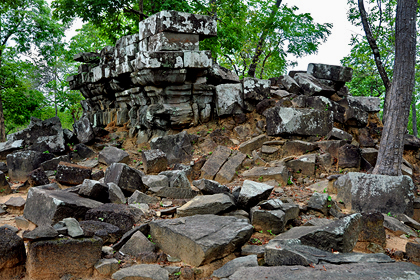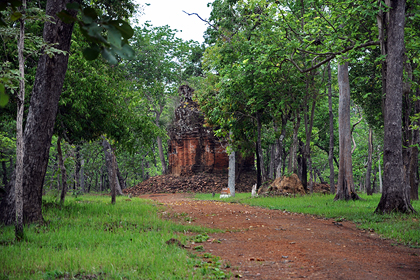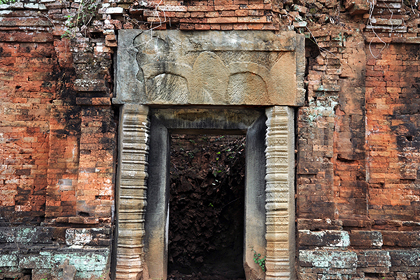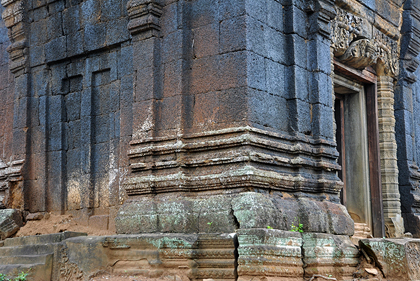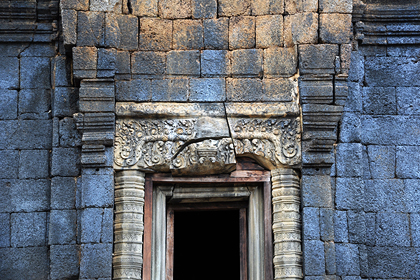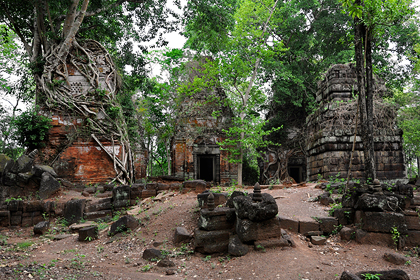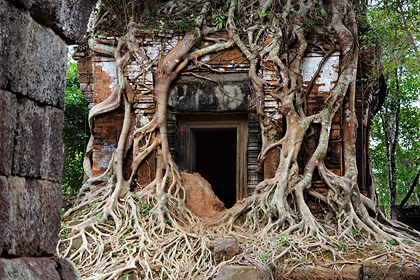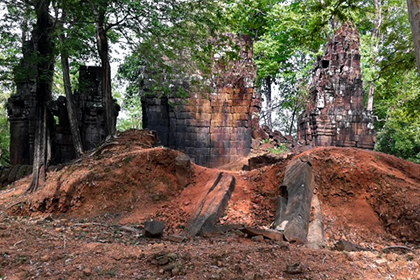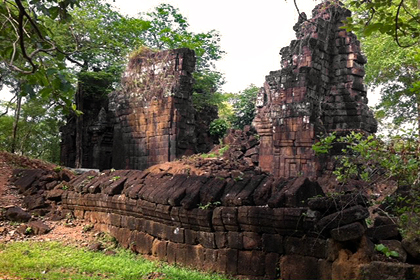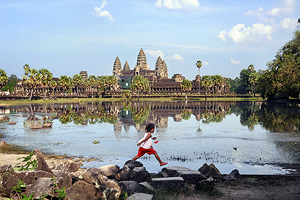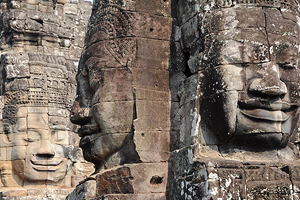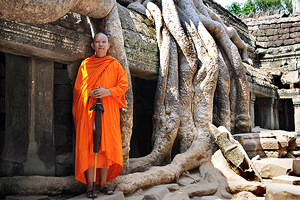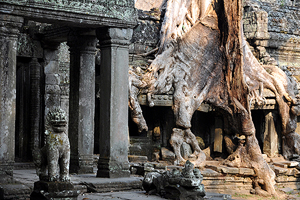Southern Temple Group in Koh Ker |
|
The southern group consists of several monuments along both sides of a highway running south from the west side of the Rahal. These monuments are in various distance from the road, but the most important ones are easy to reach.
Temples of the Southern Group consisted of single sanctuaries or groups of three, generally oriented to the east. The sanctuaries were usually square and of brick, but some of the smaller ones were of laterite. At least one of them is rectangular instead of square. The groups, and some of the single temples, too, had one or more laterite enclosures with Gopuras. The most important temples of the Southern Group are situated close to the highway. From north to south, you should at least see Prasat Chen, Prasat Neang Khmau, and Prasat Pram. |
Prasat Boeung Khma
Prasat Boeung Khma is the structure closest to the North-Eastern Group, not far away from Prasat Damrei and on the same side of the circuit road. The single tower temples is sometimes simply called Prasat Khma. Prasat Boeung Kma is a rare example of a sandstone contruction, but it is almost comletely collapsed.
|
Prasat Aob NeangThe next single tower at Koh Ker’s circuit is called Prasat Aob Neang. It is a single Prasat tower built of bricks. The bricks used in Koh Ker were smaller than those in Angkor, but of excellent quality. The layers of mortar are almost invisible. The formular of this mortar, which was also used in Angkor, for example at the contemporary Prasat Kravan, is believed to be partly organic, but still unknown. In the course of time, brick constructions turned out to be more stable than the laterite constructions in Koh Ker.
The slabs, columns and lintel of the door are made of sandstone. The lintel carving remained unfinshed. This allows to study the construction technique of lintel reliefs. |
Prasat Neang KhmauThe next structure along the road southwards to Angkor, but on the eastern side, is Prasat Neang Khmau. Another transcription is Prasat Nean Kmau. “Neang Khmau” means “Lady in black”. The temple got its romantic name from the dark bluish colour of its laterite. The eye-catching colour is caused by an oxidation process.
The Prasat tower is built of laterite on a square sandstone basement. It is in a comparatively good state of preservation. The main door opening to the west has a lintel carving depicting Brahma on a lotus, surmounted by a large undecorated pediment in the shape of an inversed U. Three heads of Brahma can be seen, which is the common way to represent Brahma two-dimensionally, because the fourth head looks towards the rear and is therefore not depicted. Brahma lost his fifth head on top of the other four, when he was decapitated by Shiva. The temple was dedicated to a Linga. The single tower is enclosed by laterite walls of approximately 50 metres square. Originally it had a wooden western Gopuram. |
Prasat Pram (Prasat Bram)
Further south at the road to Angkor, in about 800 m distance from Prasat Neang Khmau, is one of Koh Ker’s major attractions, Prasat Pram. It is the first significant ruin for visitors arriving from Siem Reap.
The santuary has five towers, “Pram” means “five”. Two of the towers are surmounted by trees with their roots strangling the brick buildings. The roots of the strangler fig of the northeastern tower are the most picturesque example of fusion of architecture and nature and a landmark of Koh Ker. This Prasat is a real fairy-tale temple. The five towers are three Prasats oriented to the east and two similar square buildings, but the latter were libraries, opening towards the main shrines, as ususal. The three Prasats are arranged in a north-south row on a shared platform, making Prasat Pram a typical longitudinal temple. These two ancillary towers have peculiar small lozenge openings in the upper levels, similar to library buildings in Roluos. The grid-pattern wholes served to aerate the buildings, hence the assumption they may have served as crematoria. Another interpretation is that these so-called libraries were shrines that housed a sacred fire. Of these ancillary monuments, the south-eastern is made of brick, while the north-eastern in laterite, is a later addition. The whole ensemble of five edifices is enclosed by a laterite wall. The Gopurams disappeared completely, presumably because they were light construction of wood. Now only the laterite base with steps remains. |
Prasat Chen (Prasat Chin)
The northernmost sanctuary of the Souther Group is Prasat Chen close to the road, on the western side. It is in about 2 km distance from the south-western vorner of the Rahal Baray.
The name “Prasat of the Chinese” was given due to a wrong interpretation of a statue found at its entrance. The impressive sculpture shows two fighting ape-men. Wearing conical Mukuta crowns and their tails running up their backs, they were interpreted as the queue worn by Chinese noblemen. This famous sculpture, best example of the dynamic style of Koh Ker, is now on display in Cambodia’s National Museum in Phnom Penh. Presumably it is a depiction of a famous Ramayana episode, the fight between the monkey brothers Sugriva and Valin. The temple is enclosed by a 2 m high laterite wall with Gopuram entrances only to the east and west. The temple proper consists of three laterite towers in a noth-south row and two libraries. Prasat Chen was dedicated to Vishnu. An inscription at Prasat Chen says it was dedicated by Jayavarman IV to Shripati. Shripati means “Shri’s patron”, Shri, a Sanskrit term for “sacred” and “holy” is a name of honour of goddess Lakshmi, Vishnu’s consort. “Shripati” can also be translated as “Holy Lord”. Besides Prasat Bantteay Pee Chan for Brahma and Prasat Bak for Ganesha, Prasat Chen is one of the temples dedicated to other Hindu deities than Shiva, who of course is the most important god for the state cult and venerated in most of Koh Ker’s temple. In front of the temple is a pedestal with feet. The rest of the sculptures are missing. They were Bhima and Duryodhana, rivals who were engaged in the last fight of the Kurukshetra battle told in India’s great Mahabharata epos, bgut this scene shows them as “knelling attendants”. The statue of Bhima is in the Norton Simon Museum in Pasadena in California, the statue of Duryodhana returned to Cambodia in December 2013 after the Cambodian government intervened when it turned up for sale at Sotheby’s auction house in New York in 2011. The sculptures had been looted in the early 1970s. |
Prasat BakThe small monument of Prasat Bak is sometimes called Prasat B or simply monument B in the list of Lunet de Lajonquière.
Though this temple, west of the road, is situated right in the centre of the Souther Group, where temples are usually exactly on an east-west axis, Prasat Bak’s axis is slightly shifted towards the north-east, where the Rahal Baray is located. The single Prasat is built of laterite, it stands upright, but it is not preserved very well and the roof collapsed. The square ground plan is only 5 metres wide. At least until 1960, the sanctuary contained a large stone elephant-head, which belonged to a colossal statue. Prasat Bak was evidently dedicated to Ganesha, the elephant-headed Hindu-deity, son of Shiva. It is a very rare example of Ganesha being the main idol of an ancient Khmer temple. The head is now part of a private collection outside Cambodia, which can not be justified by public interest, there should be no legal ways of removing findings from archaeological sites other than for safeguarding in public museums. Sra Andong PrengSra Andong Preng is a historical basin 200 m south of Prasat Thom, even today is often filled with water. The 40 m long Trapeang has steps of laterite. Supposedly it was the Royal Bath, located close to the Royal Palace, which was built of perishable materials and disappeared.
|


